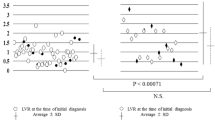Abstract
The aim of the study was to determine risk factors for the development of cystic periventricular leucomalacia (PVL) and to correlate ultrasound findings with neurodevelopmental outcome. By means of a retrospective case-control study (matched for gestational age, birth weight, sex, and year of birth) and a cohort analysis of all preterm infants with cystic PVL documented by ultrasound scans hospitalised at a local tertiary care centre between 1988 and 1998, 98 preterm infants with a gestational age ranging from 26 to 35 weeks were diagnosed as having cystic PVL. The mean day of diagnosis of periventricular echodensities was 3 ± 2 days (range 1–11 days), and of cystic PVL 21 ± 8 days (range 2–47 days). Of 79 infants (1988–1997) eligible for neurodevelopmental follow-up (91%), hemi-, di-, or tetraplegia was diagnosed in 61 (77%), normal mental outcome in 22 (28%), associated visual disorders in 41 (52%) and seizure disorders in 12 (15%) infants. Significant risk factors associated with the development of cystic PVL were premature rupture of membranes, chorioamnionitis, and hyperbilirubinaemia (odds ratios 4.665, 6.026, and 2.460 respectively). Subgroup analysis according to gestational age (26–28, 29–32, 33–35 weeks) revealed similar results despite spontaneous labour (26–28 weeks; odds ratio 4.808) and pre-eclampsia (33–35 weeks; odds ratio 3.517). Multiple pregnancy was associated with a twofold increased risk (odds ratio 2.075). The white matter damage probably accounted for the significantly higher prevalence of apnoeas (P < 0.001) and neonatal seizures (P < 0.001). Cysts located bilateral or parieto-occipital were associated with a higher risk of cerebral palsy (odds ratios 6.933 and 4.327 respectively). Solely anterior located cysts were associated with normal neurological outcome. Increasing size of the cysts was associated with increasing risk of cerebral palsy with a cut-off value of 10 mm (odds ratio 3.300 and above) and all infants with cysts of more than 20 mm diameter had cerebral palsy.
Conclusion The high prevalence of premature rupture of the membranes and chorioamnionitis further supports the role of intra-uterine infection in the pathogenesis of periventricular leucomalacia. The overall prognosis of cystic periventricular leucomalacia is poor.
Similar content being viewed by others
Author information
Authors and Affiliations
Additional information
Received: 30 September 1999 and in revised form: 28 February 2000 / Accepted: 17 March 2000
Rights and permissions
About this article
Cite this article
Resch, B., Vollaard, E., Maurer, U. et al. Risk factors and determinants of neurodevelopmental outcome in cystic periventricular leucomalacia. Eur J Pediatr 159, 663–670 (2000). https://doi.org/10.1007/PL00008403
Issue Date:
DOI: https://doi.org/10.1007/PL00008403




